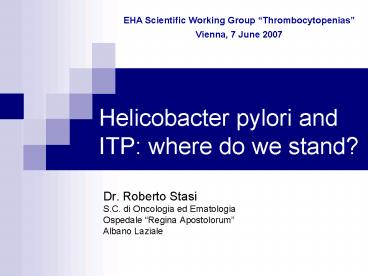Helicobacter pylori and ITP: where do we stand - PowerPoint PPT Presentation
1 / 25
Title:
Helicobacter pylori and ITP: where do we stand
Description:
Micro-aerophilic, Gram-negative, slow-growing, spiral-shaped, ... Invasive tests (biopsy through endoscope) Rapid Urease Test (RUT) Culture. Histology ... – PowerPoint PPT presentation
Number of Views:193
Avg rating:3.0/5.0
Title: Helicobacter pylori and ITP: where do we stand
1
Helicobacter pylori and ITP where do we stand?
EHA Scientific Working Group Thrombocytopenias V
ienna, 7 June 2007
- Dr. Roberto Stasi
- S.C. di Oncologia ed Ematologia
- Ospedale Regina Apostolorum
- Albano Laziale
2
Helicobacter pylori
Micro-aerophilic, Gram-negative, slow-growing,
spiral-shaped, flagellated bacterium
3
(No Transcript)
4
Prevalence of H.Pylori infection
100
90
Developing World
80
Developed World
infected
70
60
50
40
30
20
10
0
0
10
20
30
40
50
60
70
80
- Age (years)
Marshall et al. Med Clin N Am 200589313344
5
(No Transcript)
6
How To Diagnose H. pylori
- Invasive tests (biopsy through endoscope)
- Rapid Urease Test (RUT)
- Culture
- Histology
- Polymerase Chain Reaction (PCR)
- Non-Invasive tests
- Urea Breath Tests (UBT)
- Serological tests
- 13C bicarbonate assay
- Salivary assay
- Urine
- Stool antigen tests
7
H. pylori associated diseases
- 14th leading cause of death in the world
- 8th leading cause by 2010
- Gastritis
- Duodenal and gastric ulcers
- Gastric adenocarcinomas
- MALTomas
- Autoimmune diseases?
8
H. pylori infection and ITP
Gasbarrini et al. Lancet 1998352878
9
Systematic review Literature search
- Computer-assisted search of the literature
published in English since 1998. - The review was conducted independently by two of
the authors in May 2007 using the electronic
database of PubMed/MEDLINE - The MeSH subheading search was idiopathic
thrombocytopenic purpura. - Key words searched were thrombocytopenia,
thrombocytopenic purpura, idiopathic
thrombocytopenic purpura, immune thrombocytopenic
purpura, idiopathic thrombocytopenia, and immune
thrombocytopenia. These terms were combined with
the terms Helicobacter pylori or H. pylori and
with the words eradication or treatment. - The bibliographies of all retrieved articles were
searched for additional relevant citations.
10
Systematic review Article selection
- We excluded articles reporting fewer than 10
patients. - Articles reporting 10 or more total patients were
reviewed to determine whether they described any
patient with chronic ITP according to the
American Society of Hematology guidelines. - If no reference to such guidelines was made,
articles were selected only if the ITP duration
was reported and secondary causes of
thrombocytopenia had been clearly ruled out - Initially, titles and abstracts of all articles
were evaluated independently by the 2 reviewers.
Full-text articles were retrieved when they were
judged by either reviewer to possibly contain
relevant original data. Final article selection
was done independently by both reviewers, and
disagreements were resolved by consensus in all
cases. - Where duplicate or redundant publications were
uncovered, the latest and most informative
version was retained.
11
Systematic review Data extraction
- Our research strategy was to obtain
individual-level patient data from case series. - If patient-level data were not reported, we used
the group-level data. - The following data were collected in duplicate
study design and use of controls methods of H.
pylori detection demographics associated with H.
pylori infection previous ITP treatments
concomitant ITP treatments duration of ITP
before eradication treatment baseline platelet
count eradication regimen administered
toxicities associated with the eradication
regimen proportion of H. pylori eradication
definition of platelet count responses
proportion of patients with platelet count
responses time of assessment of platelet count
responses time to platelet count responses and
duration of platelet count responses.
12
(No Transcript)
13
Systematic review Final selection
- 25 studies included (42 excluded)
- 23 adult studies
- 20 prospective phase 2, 1 prospective randomized,
2 retrospective - Evaluable for efficacy 22
- Evaluable for HP prevalence 21
- Evaluable for HP eradication 23
- Evaluable for demographics of HP-positive 15
- Only a few studies with group-patient data
reported Mean SD values - Inconsistent platelet response criteria
14
(No Transcript)
15
Results
- Evaluable for HP infection 1440
- N of infected 942
- of infected 65.4
- Evaluable for HP eradication 780
- N of eradicated 660
- of eradicated 84.6
- Evaluable for response 652
- N of responders 368 (0/41 in non eradicated)
- of responders 57.7
- N of responders with severe ITP (Plts lt30 x
109/l) 11
16
Demographics Age
17
Demographics Male gender
18
Demographics ITP duration
19
Demographics baseline platelet count
20
Response rate Japan vs other countries
Plt 0.0001
21
Higher response rates in studies with higher
infection rates
R0.5098, P0.018
22
Predictor of response ITP duration
23
Pathogenesis of H. pylori-associated ITP
- Molecular mimicry (antibody production in
response to antigens that cross-react against
various platelet glycoprotein antigens) - PAIgG cross-react with the CagA protein1
- CagA antibodies cross-react with a peptide
specifically expressed by platelets of patients
with ITP2 - Most Japanese H. pylori strains are positive for
CagA3 - LPS-induced phagocytosis of IgG-opsonized
platelets4
1Takahashi et al Br J Haematol.
200412491-96 2Franceschi et al. Ann Intern Med.
2004140766-767 3Maeda et al. Gut.
199944336-341 4Semple et al. Blood 2007
20071094803-4805
24
LPS enhances Fc receptormediated phagocytosis of
IgG-opsonized platelets
Platelets were incubated with either (A)
autoantibody-negative sera samples 1 to 4 or (B)
autoantibody-positive sera samples 5 to 8 and
either no LPS ( ) or 0.1 ( ) µg LPS and
incubated with THP-1 cells
Semple et al. Blood 2007 20071094803-4805
25
Conclusions
- H. pylori infection is a common finding in ITP,
particularly in older patients and in countries
other than USA - Response rates are variable. The chances of
response are higher in Japanese patients with a
short disease history and a mild ITP - The role of difefrent H. pylori strains in the
pathogenesis of ITP are yet to be defined































